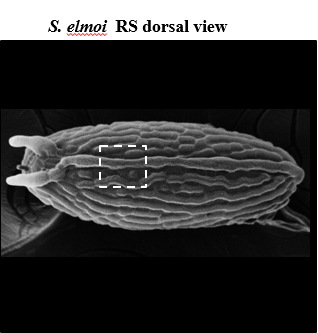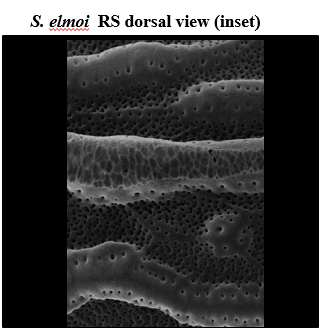The following post is part of a series of blog posts based on interviews that Nia Nikolaidis (an undergraduate in the Savage lab) conducted with different members of the Biology Department at Rutgers University-Camden for her project about the use of microscopy for Rutgers Day 2016.
Alessio Russomanno, B.A., B.S.
Teaching Assistant
Biology Department
 Alessio Russomanno, a graduate student in Dr. Nir Yakoby’s lab describes the pro-cess he takes when characterizing new fly species during oogenesis, or embryo develop-ment. He does this by characterizing different components of the entire eggshell, both in-side and out, and at a variety of developmental stages. On this specific species, a distinct respiratory stripe can be seen. Also the dorsal ridge, and dorsal appendages (which are shorter in this species), and thick Chorion protein deposits along the eggshell are key char-acteristics when characterizing this species in the embryonic stages.
Alessio Russomanno, a graduate student in Dr. Nir Yakoby’s lab describes the pro-cess he takes when characterizing new fly species during oogenesis, or embryo develop-ment. He does this by characterizing different components of the entire eggshell, both in-side and out, and at a variety of developmental stages. On this specific species, a distinct respiratory stripe can be seen. Also the dorsal ridge, and dorsal appendages (which are shorter in this species), and thick Chorion protein deposits along the eggshell are key char-acteristics when characterizing this species in the embryonic stages.
In his previous work as an undergraduate student in Dr. Yakoby’s lab, he studied the cold tolerance of four different species of Drosophila: Melanogaster, Funebris, Moja-vensis, and Virilis. Melanogaster, the most common species, is very widespread and adapts to a variety of temperatures. Funebris lives in Alaska, and is accustomed to colder temper-ature. Mojavensis is from the desert, and Virilis, subtropic areas. Different responses could be seen across ATP levels, fitness, and mobility. All of these factors affect the fly’s ability to survive in cold climates.
 Other work being done in Dr Yakoby’s lab includes looking at how different genes turn on during the 14 stages of Drosophila oogenesis. This creates different tissue pattern-ing which they are able to correlate with the structure of the eggshell. An example would be on the dorsal appendages, if we see the gene Rhomboid (Rho) expressed, this will be-come the floor of the dorsal appendages, and where Broad (BR) is expressed will become the future roof. In different species, these domains can be smaller or larger. Another pro-ject in the lab is the drive of foreign gene expressions into foreign areas.
Other work being done in Dr Yakoby’s lab includes looking at how different genes turn on during the 14 stages of Drosophila oogenesis. This creates different tissue pattern-ing which they are able to correlate with the structure of the eggshell. An example would be on the dorsal appendages, if we see the gene Rhomboid (Rho) expressed, this will be-come the floor of the dorsal appendages, and where Broad (BR) is expressed will become the future roof. In different species, these domains can be smaller or larger. Another pro-ject in the lab is the drive of foreign gene expressions into foreign areas.